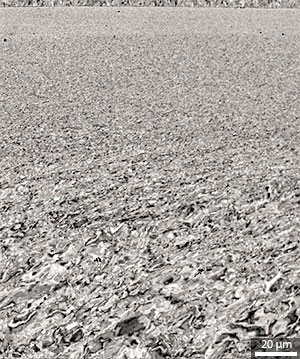| May 30, 2011 |
Tailoring the size of grains in a metal can make it both strong and ductile
|
|
(Nanowerk News) One of the ways to make a metal stronger is to roll or press it. The working prevents the formation of structural defects, which typically make it easier for the metal to deform. Worked metals are therefore stronger and can support a heavier load, but they are often brittle and prone to fracturing.
|
|
Using a mechanical grinding technique that allowed them to control the structure of a metal's surface on the nanoscale, Ke Lu and colleagues from the Chinese Academy of Science's Institute for Metal Research in Shenyang have overcome this frustrating tradeoff between strength and brittleness to produce a protective copper surface that is both strong and ductile ("Revealing Extraordinary Intrinsic Tensile Plasticity in Gradient Nano-Grained Copper").
|
 |
| A scanning electron microscopy image of gradient nanograined copper.
|
|
"This surface layer could act as an ideal coating for a material that would enhance wear and corrosion resistance and reduce fatigue," says Lu.
|
|
Most metals are polycrystalline, meaning they are made up of many small crystalline 'grains', each with the same structure but oriented in random directions. Researchers have long known they could make polycrystalline materials stronger by reducing the size of the grains to a few hundred nanometers. But similar to the effects of worked metals, smaller grains reduce a metal's ductility.
|
|
When nanograined copper films are placed on polymer substrates, however, they become substantially more ductile because the polymer distributes the strain. Unfortunately, the copper films are prone to peeling away in these hybrid structures.
|
|
Lu and his team recognized that nanograined copper would be more robust if placed on a copper base. Applying a technique they developed, Lu and his team 'cold-ground' the surface of a coarse-grained copper rod. The mechanical treatment, which involves pressing a curved tip roughly the size of an eraser into the surface of a rotating cryogenically cooled copper rod, creates a distribution of grain sizes, from 20 nanometers at the surface to a few hundred nanometers just below the surface.
|
|
The distribution of nanograins (see image) has a striking effect. A stand-alone film of nanograined copper can only be pulled about 2% beyond it's original length before it breaks. On top of the coarse-grained copper rod, however, the film can be stretched as much as 100% without cracking, says Lu.
|

